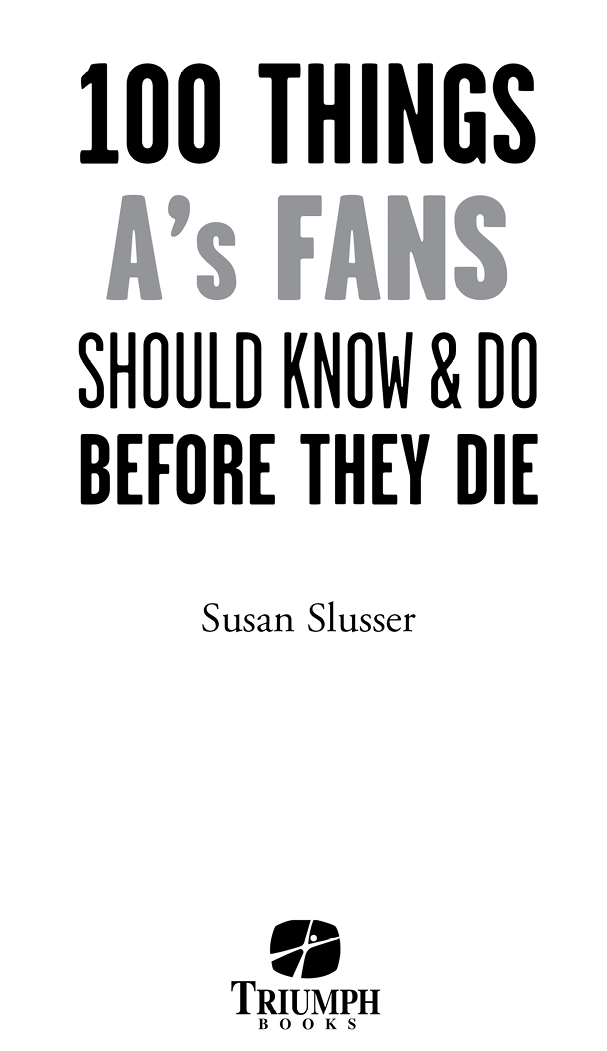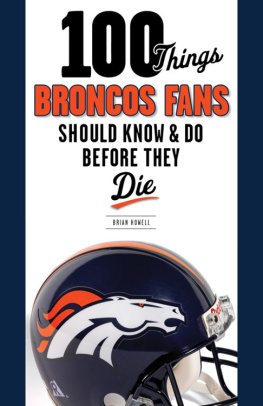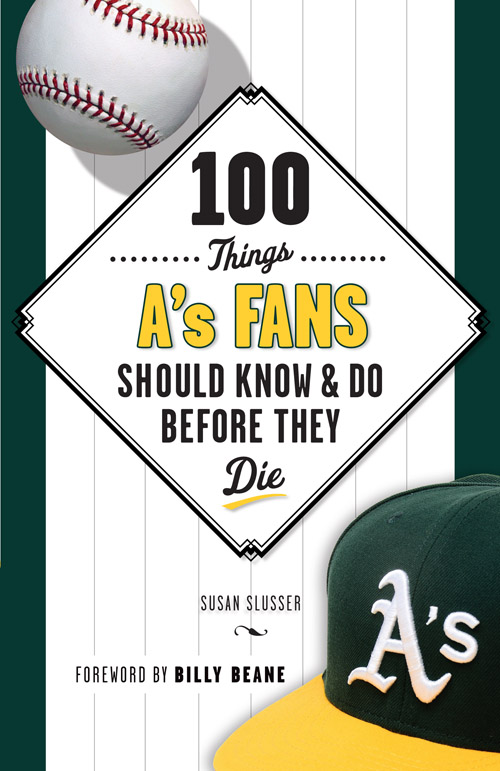
In memory of Joyce Slusser, a true As fan
Contents
Foreword by Billy Beane
The history of the As is filled with characters and stories as rich and colorful as nearly any organization in sports. From Connie Mack through Charlie Finley and from Sandy Alderson through the teams of the 2000s and today, each generation of As baseball has put its stamp on history in a unique way.
Some of the greatest teams of all time were the As of the early 30s under Connie Mack. From 1929 to 1932, Macks teams averaged more than 101 wins and dominated the game even more than the famed Yankees teams of that era. Though, in a precursor of things to come, Mack was the first one to have to sell off players for financial reasons. History repeated itself in the early 70s, when Charlie put together three World Series champions, only to see many of his players go elsewhere via free agency. When the Haas family took over and Sandy was running the team, the personality of the club changed from the mustachioed gang of Catfish and Rollie to the rock stars of the 80s that were Rickey and Jose and McGwire. But, the success of the franchise continued. That team, led by Hall of Famer Tony La Russa and on which I was lucky enough to be a player for a brief moment, went to three straight World Series and set the standard for excellence over the course of almost a decade.
The game began to change when I moved from the field into the front office in the early 90s, but the circumstances were the same as theyd always been. The As were always trying to compete with bigger clubs that had more than we did; whether in Philadelphia or Kansas City or Oakland, thats been the case. Now in this era, where new stadiums and huge TV contracts create seemingly unlimited revenue streams around the game, we still face those same challenges.
And, with those challenges come solutions that have to be inventive and creative. Mack, Finley, and Aldersonall three were considered great innovators during their time with the As. Weve tried to further that innovation in my 17 years here as general manager. Ive done some things differently than those who came before me, but always tried to keep the spirit of the franchise intact. To some extent weve taken on the personality of the Bay Area and the tech boom around us, using whatever information we could capture to help put a winning team on the field. But, the players on the field and the personalities they bring remain the heart of the As.
My first year as GM in 1998 was Rickeys last year in Oakland. Theres no doubt Rickey is the best player in Oakland As history; an incredibly complete player who could impact the game in every way. And there have been some great players whove followed in his footsteps over the last two decades. Jason Giambi was the first star to play here in Oakland during my tenure. Eventually, Miguel, Tim Hudson, and Eric Chavez joined Jason and were then followed by Zito, Mulder, and Ramon Hernandez to form those great teams of 20002003. That group gave way to guys like Dan Haren and Nick Swisher, who were joined by Hall of Famer Frank Thomas for his magical season in 2006. And then you have the most recent collection of personalities, led on the field by Bob Melvin, who provided the most enjoyable season of my term as GM in 2012. That team went almost entirely unnoticed until the last day of the season when we won the AL West after never having led the division for a single day.
Whether in Philadelphia, Kansas City, or Oakland, the As have never lacked for color. Theres a reason our rabid, knowledgeable, and loyal fan base has connected so much with these teams over the years. The players tend to take on the personality of the fans, whose own creativity and passion spills out of the stands and onto the field. Its not uncommon to hear opposing players say that Oakland is one of the toughest places in the game to play.
The As, and those of us who love the organization, never quite know what tomorrow will bring. We take it day by day and have learned to enjoy the team we have in the moment. But, no one can take away the incredible history of this teamthe stories, the personalities, the fans, and the characters are what have made the As one of the greatest franchises in sports.
Billy Beane
1. Rickey Henderson
Leading off, of course: No. 24, Rickey Henderson.
On June 24, 1979, the As dropped a doubleheader to Texas, forgettable enough in a terrible season, except for the fact that one of the greatest baseball players of all time made his debut in left field. In the first game, the 20-year-old went 2-for-4 with a double and a stolen base, a statistic that became synonymous with Henderson.
The one-time Oakland Tech football star would soon team with a new As manager to turn the franchises fortunes aroundsaving major-league baseball in the East Bay.
From his first moments, Rickey Henderson was in a hurry. He was born in the back seat of an Oldsmobile en route to the hospital in Chicago on Christmas Day, 1958.
In Hendersons autobiography with John Shea, Off Base, Confessions of a Thief, he credits his speed to chasing chickens as a small child at his grandmothers home in Alabama; after moving to Oakland, he raced city buses.
Baseball wasnt his early passion, though. Football was Hendersons game, and he had to be dragged to the diamond by his brother and by some neighborhood coaches who realized they needed the areas top athlete on their teams, even if they had to bribe him.
I hated baseball, Henderson said from a distance of more than 40 years. I played because of my brother; he loved it, but I hated the game. A baseball player was nowhere near what I wanted to be.
But I had a couple of father figures who kept me playing. Because I was good at it, I was playing on two teamsthey got me to play by bringing me cocoa and donuts to get me out of bed, or I never would have gone to the field. Id play in Oakland and Berkeley, one game at 10:00 am and the next one at 2:00.
Henderson wound up playing with Louis Burrell, who like his brother, Stanley MC Hammer Burrell, worked in the As clubhouse; Oakland players of the mid-70s remember Louis Burrell bringing Henderson around and telling them that here was a future big-leaguer. Another As connection: Dave Stewart, the future Oakland star right-hander, was the catcher on Henderson and Burrells Connie Mack team.
Henderson was, famously, cut from the varsity baseball team as a sophomore. He was a high school All American in football, however, and he received 20 scholarship offers, with USC and UCLA among the suitors.
I was going to go to Arizona State because of Reggie Jackson and because I could play football and baseball, Henderson said. My mom was the one who decided against football. She said, I want you to play baseball. I said, Mom, I dont like baseball, I just did it to get away from my chores.
One scout told me I had a better chance at baseball. He said I was the best athlete he had ever seen and I was going to make it. A lot of teams didnt like me, though, because I hit right-handed and threw left-handed.
Thats an unusual combo, with only a few dozen in the fraternity (including, lore has it, Eddie Gaedel, though the undersized pinch hitter never threw a baseball at the big-league level).
When I got into baseball, I just looked to see what everyone else was doing, and they all hit on the right side, Henderson said. So I did it from the right side, even though Im left-handed. People to this day wonder why I wasnt a left-handed hitter, but its only because I was watching the other kids.




